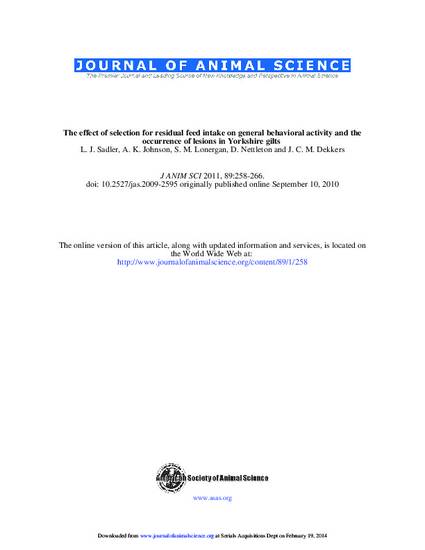
The objectives of this study were to determine the extent to which selection for decreased residual feed intake (RFI) affects pork composition and quality. Pigs from the fifth generation of selection for decreased RFI (select) and a randomly selected line (control) were utilized. Two experiments were conducted. In Exp. 1, barrows (22.6 ± 3.9 kg) from select and control lines were paired based on age and BW. The test was conducted in 8 replicates of pairs for the test period of 6 wk. Calpastatin activity and myosin isoforms profile were determined on samples from the LM. Control barrows were heavier (59.1 vs. 55.0 kg; P < 0.01) at the end of the test period. Calpastatin activity was greater (P < 0.01) in LM of select barrows than control barrows. In Exp. 2, composition and quality of gilts (114 kg) from control and select lines were determined. The model included fixed effects of line, slaughter date, melanocortin-4 receptor (MC4R) genotype, barn group, line × slaughter date, genotype × line interactions, a covariate of off-test BW, and sire, pen, and litter fitted as random effects. The select line (n = 80) had 0.043 kg less (P < 0.05) RFI per day than the control line (n = 89). Loin quality and composition were determined at 2 d postmortem. Desmin degradation was measured at 2 and 7 d postmortem. Purge, cook loss, sensory traits, and star probe texture were measured at 7 to 10 d postmortem on cooked chops. Residual correlations between RFI and composition and quality traits were calculated. Compared with the control line, carcasses from the select line tended to have less (P = 0.09) backfat, greater (P < 0.05) loin depth, and greater (P < 0.05) fat free lean. Loin chops from the select line had less (P< 0.01) intramuscular lipid content than loin chops from control line. Significant residual correlations between RFI and both tenderness (r = 0.24, P < 0.01) and star probe (r = −0.26, P < 0.01) were identified. Selection for decreased RFI has the potential to improve carcass composition with few effects on pH and water-holding capacity. However, decreased RFI could negatively affect tenderness and texture because of decreased lipid content and decreased postmortem protein degradation.
Available at: http://works.bepress.com/elisabeth_huff-lonergan/21/

This article is from Journal of Animal Science 89 (2011): 192–200, doi:10.2527/jas.2010-2861.